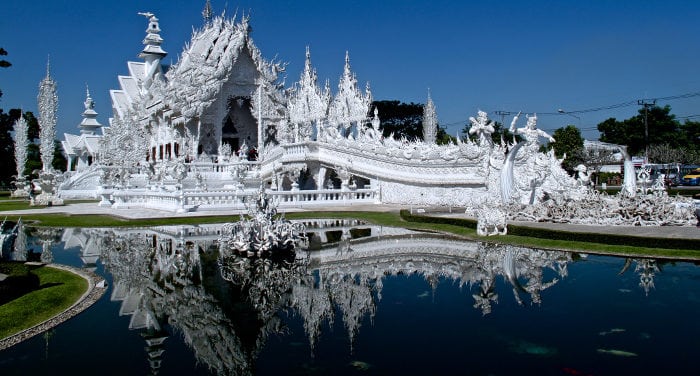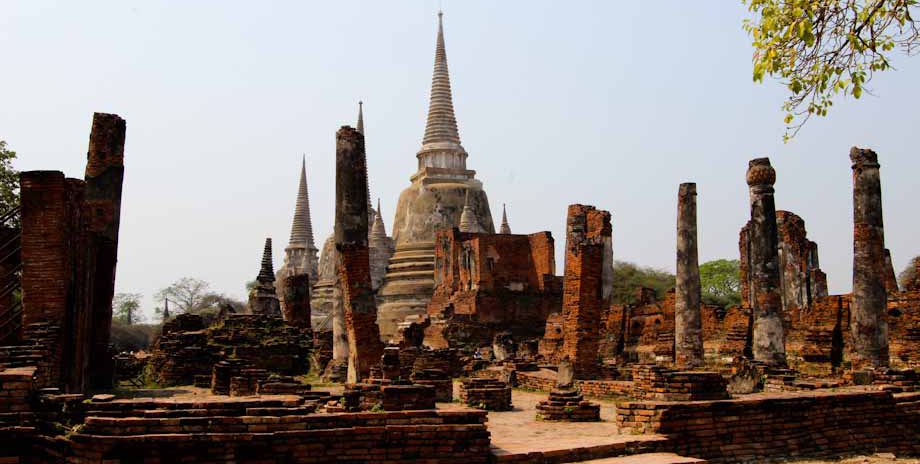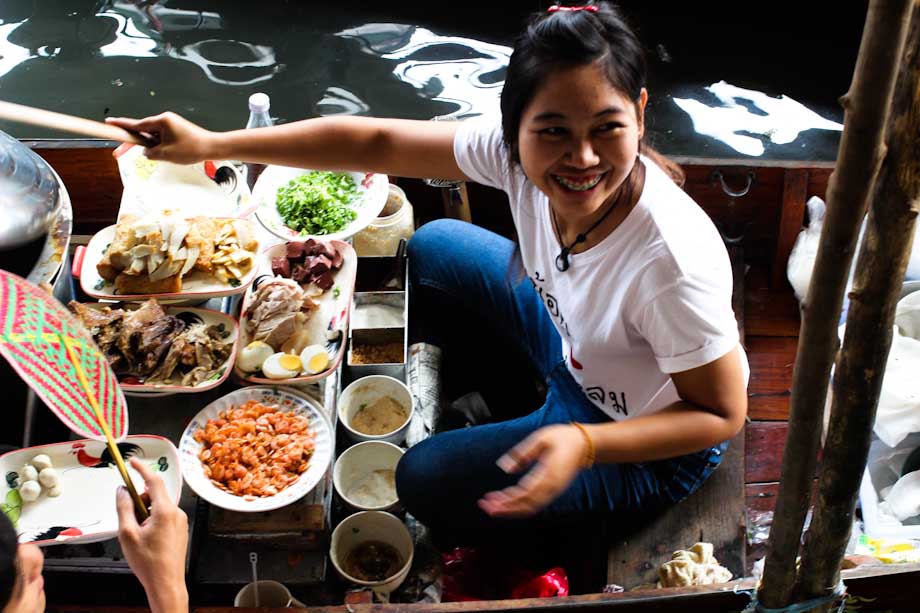
General information
Chiang Rai, a city considered noble due to its past as the capital of the Kingdom of Lanna, is especially famous for its proximity to the golden triangle; an area on the Mekong River where the territories of Thailand, Laos, and Myanmar meet, forming a triangle. The golden triangle is widely known abroad as world’s most important region, second only to Afghanistan, for the production of opium during the 50’s.
Chiang Rai is however known for its Buddhist temples, particularly the marvelous White Temple (in Thai: Wat Rong Khun), located a few kilometers outside the middle of the city.
The city of Chiang Rai is about 800 kilometers from Bangkok, and is the capital of the province of the same name. Just a little smaller than Chiang Mai, Chiang Rai has a population of 70,000 inhabitants. Its territory is mainly mountainous, being situated 600 meters over sea level. This characteristic makes it so that in winter the lowest temperatures go down to even 15 degrees, which is very low for Thailand.
Visiting Myanmar or Laos from Chiang Rai
Its strategic position makes Chiang Rai a perfect spot for those that also want to visit Myanmar and Laos.
Regarding the first destination, you can take a taxi from the center of Chiang Rai which will take you to the border checkpoint (Mae Sot), or a bus. Once you get to the so-called friendship bridge, the bridge connecting the customs office of Mae Sot in Thailand and Myawaddy in Myanmar, you can follow the procedures for visas on arrival directly at the border immigration office, then go on for another kilometer toward the bus station.
Up until a few years ago, this connection point between Thailand and Myanmar was frequently used by foreign residents of the north of Thailand to get a new long-term visa. The strategy was to leave from the Thai border station to then immediately re-enter and get a new long-term visa.
For a few years now though, the Thai government has decided to ban this type of visa and make a 24 hour stay in a foreign country mandatory before re-entering Thailand and getting a new visa.
If instead your intention is to go to Laos, from the bus station in Chiang Rai you’ll find a bus that leaves every 30 minutes, heading to the border point of Huay Xai. The price of a bus ticket is 70 THB a person.
Be careful because the bus won’t leave you near the border immigration office, but rather a bus stop about 2 kilometers from the customs office, where there will be many tuk-tuks that will ask from 200 to 300 THB to take you to the border. In this case the best idea is to share one of these tuk-tuks with other travelers, negotiating the price.
How to get to Chiang Rai
Air
Chiang Rai is easily reached by air via the famous low cost Asian airlines, like AirAsia or NokAir. It is possible to reach Chiang Rai from various Thai cities such as Bangkok, Phuket, and Hat Yai. The price for a round-trip ticket Bangkok is around 1,500 THB a person.
The city’s airport is also well-connected to foreign destinations such as Cambodia, India, Japan, and many other Asian nations.
The airport is located several kilometers outside of the city. Upon landing you’ll find a taxi service that will assign you a car to bring you to your hotel. In this case the price will start at a base of 100 THB a car.
Bus
You can also get to Chiang Rai by taking a bus from the Thai capital, Bangkok (Morchit station). The cost varies between 596 and 694 THB a person, and tickets are easily purchased online through the site 12go.asia.
Click here to read our guide on buses in Thailand.
Train
You can’t get to Chiang Rai by train. The only option is to go to Chiang Mai and then take a direct bus to Chiang Rai.
Bus tickets go for between 129 and 258 THB, timetables are available on the company Greenbus’s website, which arranges transport for the north of Thailand also from Phuket (23 hours of travel!). This company is used both by locals and tourists. They also arrange VIP buses, where you can travel in first class. The price of a ticket includes a small bottle of water and snacks.
Another possible option for getting to Chiang Rai from Chiang Mai, is to take a taxi. The travel time is reduced, but the cost goes up noticeably, getting up to 3,000 THB.
Click here to read our guide on traveling around Thailand by train
Where to stay in Chiang Rai
Chiang Rai, like Chiang Mai, is a rather inexpensive city that offers a wide gamut of hostels, guesthouses, and hotels. In the center, specifically near the pedestrian area where the night market is held, there are various charming, low-cost guest hotels.
One hotel that I’d recommend is Baansiri Chiangrai. It’s just a few minutes from the center, in a new building, the rooms and bathrooms are extremely clean, the staff is very nice and breakfast is included.
Click here to read reviews of the hotels we recommend in Chiang Rai.
Where to eat in Chiang Rai
The city teems with small restaurants, featuring both Thai and other cuisines. What I don’t recommend is eating in restaurants located inside the night market.
The range of food available is varied from Japanese to Italian food: in Chiang Rai you can find something for all budgets.
A really cool thing to do is stop and get a coffee or smoothie from one of the bars that offer this type of service (run by young mothers or youths with social difficulties). An example is Destiny Café, located near the gold clock in the middle of town.
What to see in Chiang Rai
Chiang Rai is known for its many Buddhist temples located in splendid oases of peace. The most beautiful and special remains the aforementioned White Temple. Constructed in 1997 by Chalermchai Kositpipat, a local artist, it has become the symbol of the city. Up until just recently, entrance to the temple was free, but for a few months now the price is 50 THB a person.
From the outside it is possible to note the extravagance and difference of this monument compared to other temples in the country. The first part of the temple, which represents hell, is to be walked barefoot without turning back, otherwise a little man who has been tasked with monitoring this procedure from outside the temple, will call at you with a megaphone and invite you to go inside the monument without stopping.
Inside the temple, as opposed to other Buddhist temples where there are usually depictions representing the history of the Buddha, it depicts the present world (including the September 11th attacks and Pikachu!).
In the majority of cases the white temple is included as part of the various tours offered by tourist agencies.The most interesting and recommended tour takes in the white temple, the black house, and golden triangle.
In this day tour you will also visit other lesser-known tourist attractions, such as the monkey quarry, the long-necked women’s village and the opium museum.
When it comes to things to do in town, many hotels offer the opportunity to rent bicycles or scooters, for less than 300 THB a day. The old city is easily seen on foot, especially if you stay for more than one night.
The best temple to visit, other than the White Temple, is Wat Phra Kaew. What makes this temple special is its jade-carved Buddha, equal to the one found in the royal palace in Bangkok.
The gold clock located in the middle of town is lit up in a thousand colors and is also quite interesting.
Another way to visit the various Buddhist temples spread throughout the city is to take the free little train that leaves for a spot located behind the monument dedicated to the king Mengrai.
The train is free and leaves at 1:30 p.m. The only little problem is that the train only leaves when there’s a group of at least 6 people.
If though, these 6 people don’t write their names on the list located at the office next to the train, but show up right at 1:30 p.m., the train won’t leave. If you want to take advantage of this option, book at least a half and hour ahead of time.
To conclude, a special thing to do is immerse yourself further in the culture of the land by learning to cook some Thai dishes. The Suwannee Thai Cooking Class offers personalized courses, such as group lessons, for prices starting from 1,200 THB a person, for groups of three or more people.
If you’re looking for something a little more inexpensive, you can choose the school called Cook Thai Yourself, where prices are fixed at 1,000 THB a person.
Photo Credits: ![]() Wat Rong Khun (1) by David
Wat Rong Khun (1) by David




Hello Stefania Battaglia,
Thank you for the article on Chiang Rai. I live in Central China and plan to visit Thailand early in 2018.
I am interested in textiles and textile making. A Thai teacher from our university told me about the Li people and their work. Do you know where I could see this embroidery?
Also, can a woman travel there alone safely?
Thank you!